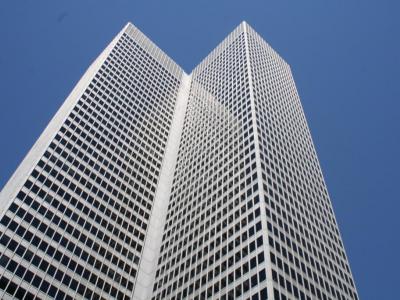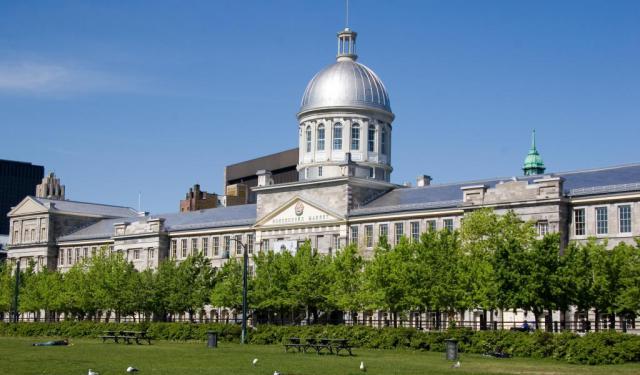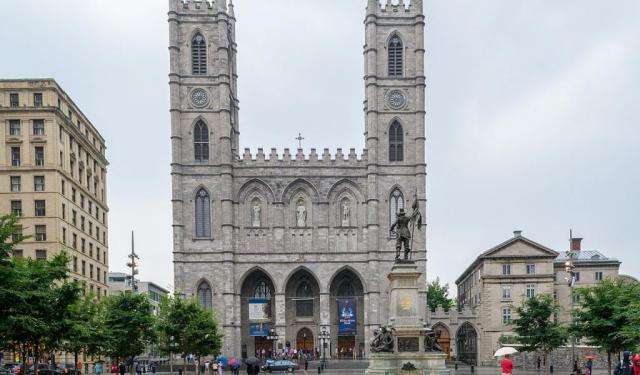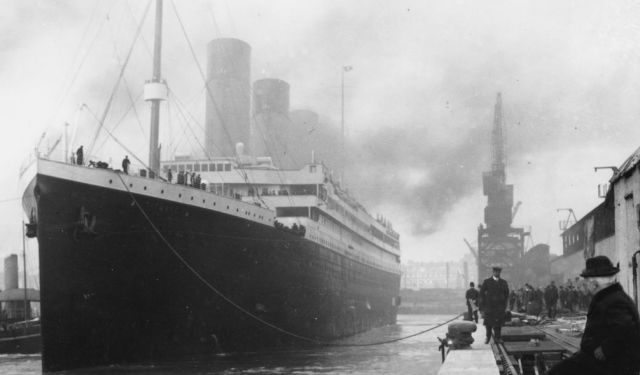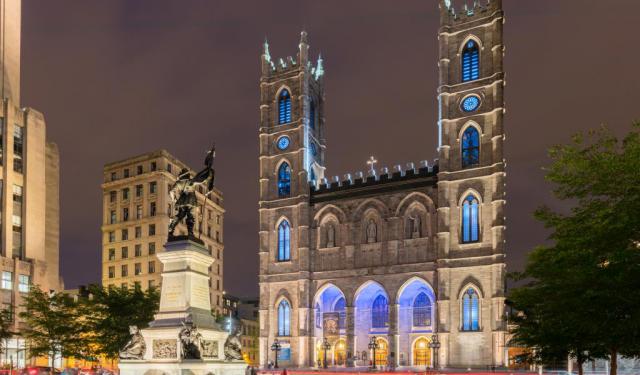Place Ville-Marie, Montreal
The Place Ville-Marie skyscraper in Montréal has been a source of controversy due to its close proximity to many of the city's landmarks and the significant changes it would bring to the downtown core. The project was part of Mayor Jean Drapeau's vision to transform Montréal into a modern metropolis, and he personally chose the name to pay homage to the city's French Catholic colony established in 1642.
The skyscraper was intended to house the headquarters of the Royal Bank of Canada, which it still does today, leading to the relocation of the city's financial district from Old Montréal to downtown. It became the largest and most intricate office building the world had ever seen.
While the name "Place Ville Marie" commonly refers to the cruciform building itself, it also encompasses the four smaller office buildings constructed around it in 1963 and 1964, as well as the urban plaza situated atop the main section of the shopping promenade and between the buildings.
Renowned architects I. M. Pei and Henry N. Cobb designed this international-style structure, which was completed in 1962. At the time, it was the tallest building in the British Commonwealth and the only cruciform building in the city.
Originally, the location of Place Ville-Marie was occupied by a large railway trench. Consequently, much of the building was erected above the tracks, requiring it to be exceptionally resilient to vibrations. As a result, it stands as Montreal's most earthquake-resistant office tower.
The complex is the heart of Montréal's Underground City, the world's busiest. It connects to over 1,600 businesses, subway stations, and a vast downtown tunnel network. A rooftop beacon shines white beams, visible up to 50 kilometers (31 miles) away.
Tip:
If you visit during Christmas, you will find a huge Christmas tree at the central court.
The skyscraper was intended to house the headquarters of the Royal Bank of Canada, which it still does today, leading to the relocation of the city's financial district from Old Montréal to downtown. It became the largest and most intricate office building the world had ever seen.
While the name "Place Ville Marie" commonly refers to the cruciform building itself, it also encompasses the four smaller office buildings constructed around it in 1963 and 1964, as well as the urban plaza situated atop the main section of the shopping promenade and between the buildings.
Renowned architects I. M. Pei and Henry N. Cobb designed this international-style structure, which was completed in 1962. At the time, it was the tallest building in the British Commonwealth and the only cruciform building in the city.
Originally, the location of Place Ville-Marie was occupied by a large railway trench. Consequently, much of the building was erected above the tracks, requiring it to be exceptionally resilient to vibrations. As a result, it stands as Montreal's most earthquake-resistant office tower.
The complex is the heart of Montréal's Underground City, the world's busiest. It connects to over 1,600 businesses, subway stations, and a vast downtown tunnel network. A rooftop beacon shines white beams, visible up to 50 kilometers (31 miles) away.
Tip:
If you visit during Christmas, you will find a huge Christmas tree at the central court.
Want to visit this sight? Check out these Self-Guided Walking Tours in Montreal. Alternatively, you can download the mobile app "GPSmyCity: Walks in 1K+ Cities" from Apple App Store or Google Play Store. The app turns your mobile device to a personal tour guide and it works offline, so no data plan is needed when traveling abroad.
Place Ville-Marie on Map
Sight Name: Place Ville-Marie
Sight Location: Montreal, Canada (See walking tours in Montreal)
Sight Type: Attraction/Landmark
Guide(s) Containing This Sight:
Sight Location: Montreal, Canada (See walking tours in Montreal)
Sight Type: Attraction/Landmark
Guide(s) Containing This Sight:
Walking Tours in Montreal, Canada
Create Your Own Walk in Montreal
Creating your own self-guided walk in Montreal is easy and fun. Choose the city attractions that you want to see and a walk route map will be created just for you. You can even set your hotel as the start point of the walk.
Historical Buildings Walking Tour
Whenever you gaze upon the historical buildings of Montreal, you are reminded that the true measure of a city's greatness lies in its ability to preserve its past while embracing its future. Old Montreal – home to four centuries of architecture shaped by French sophistication and English practicality – is a place all its own.
Here, modern buildings coexist with some of the oldest and... view more
Tour Duration: 2 Hour(s)
Travel Distance: 3.8 Km or 2.4 Miles
Here, modern buildings coexist with some of the oldest and... view more
Tour Duration: 2 Hour(s)
Travel Distance: 3.8 Km or 2.4 Miles
Historical Churches Walking Tour
The religious fervor that inspired French settlers in the mid-17th century to build a “Christian commonwealth” on North American soil gave rise to a number of churches, chapels, and cathedrals. Each sacred edifice in Montreal's ecclesiastical panorama – notably, in its religion- and architecture-infused oldest area, Vieux-Montréal – is a testament to the divine craftsmanship and... view more
Tour Duration: 2 Hour(s)
Travel Distance: 4.2 Km or 2.6 Miles
Tour Duration: 2 Hour(s)
Travel Distance: 4.2 Km or 2.6 Miles
Old Montreal Walking Tour
Old Montreal (Vieux-Montréal) is a historic neighborhood southeast of the downtown area, home to many architectural monuments of the New France era. Founded by French settlers in 1642 as Fort Ville-Marie, the settlement gave its name to the city borough of which it is now part.
Most of Montreal's earliest architecture, characterized by uniquely French influence, including grey stone... view more
Tour Duration: 2 Hour(s)
Travel Distance: 3.3 Km or 2.1 Miles
Most of Montreal's earliest architecture, characterized by uniquely French influence, including grey stone... view more
Tour Duration: 2 Hour(s)
Travel Distance: 3.3 Km or 2.1 Miles
The RMS Titanic Walking Tour
Built as the ship of dreams, the RMS Titanic went down in history as the one that carried “both the hopes and the tragedies of a generation.” The luxury cruiser sank on her maiden voyage across the Atlantic in the early hours of April 15, 1912, and today is largely remembered throughout the world, in part, due to the blockbuster movie starring Leonardo DiCaprio.
Although Montreal's... view more
Tour Duration: 2 Hour(s)
Travel Distance: 3.5 Km or 2.2 Miles
Although Montreal's... view more
Tour Duration: 2 Hour(s)
Travel Distance: 3.5 Km or 2.2 Miles
Montreal Introduction Walking Tour
The second-most populous city in Canada, Montreal is an old, yet at the same time, modern metropolis, flagship of Canada's Québec province. Sitting on an island in the Saint Lawrence River, with Mount Royal at its center, the city owes its name to this triple-peaked hill (Mont Royal in modern French, although in 16th-century French the forms réal and royal were used interchangeably).
The... view more
Tour Duration: 2 Hour(s)
Travel Distance: 3.6 Km or 2.2 Miles
The... view more
Tour Duration: 2 Hour(s)
Travel Distance: 3.6 Km or 2.2 Miles
Useful Travel Guides for Planning Your Trip
Montreal Souvenirs: 15 Trip Mementos to Bring Home
The outpost of Frenchness in North America (and the world's 2nd largest francophone city after Paris), Montreal is the meeting point of the New and Old World styles, the collision of the French, English and Aboriginal cultures. The historical and ethnic uniqueness of the city is seen throughout...
